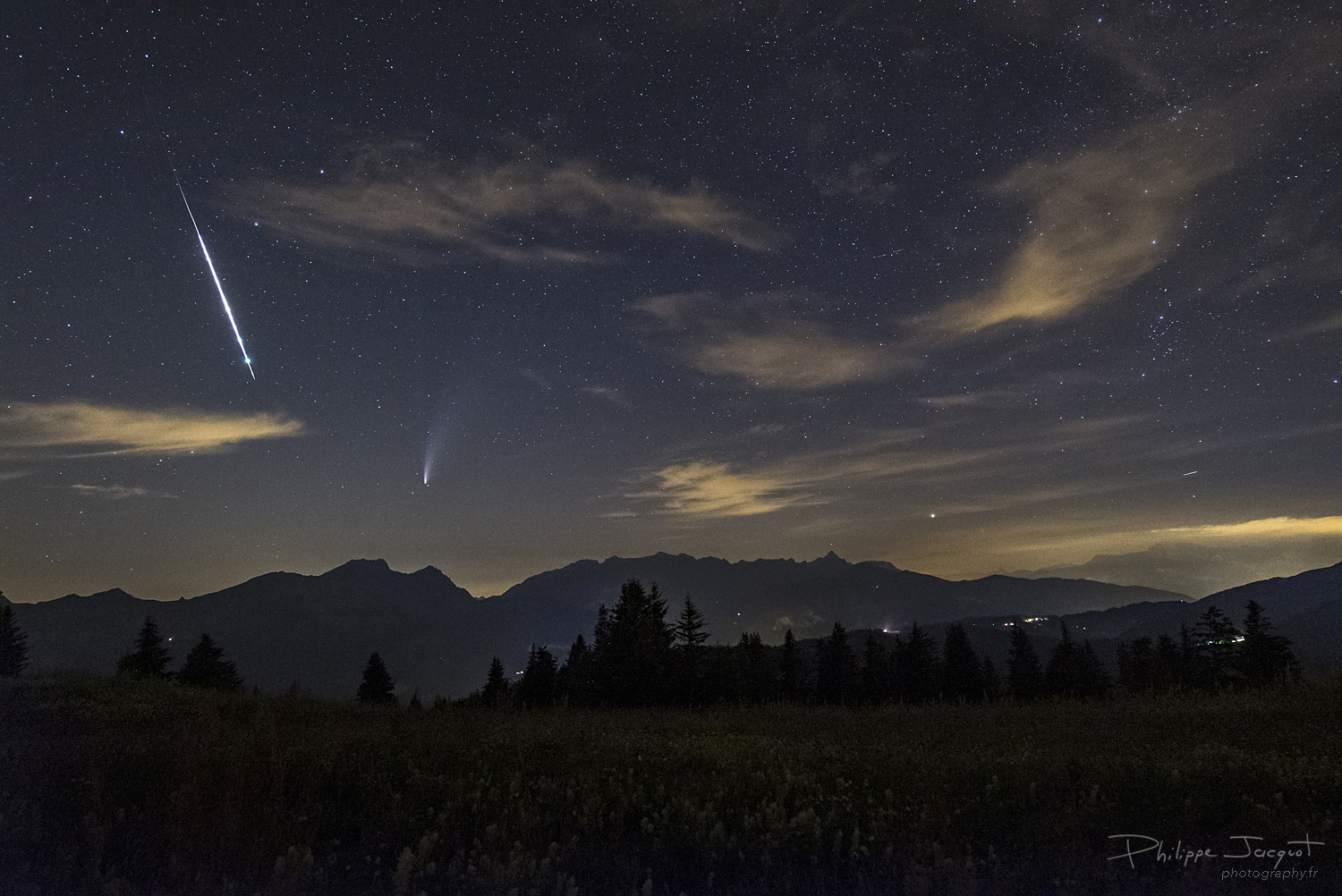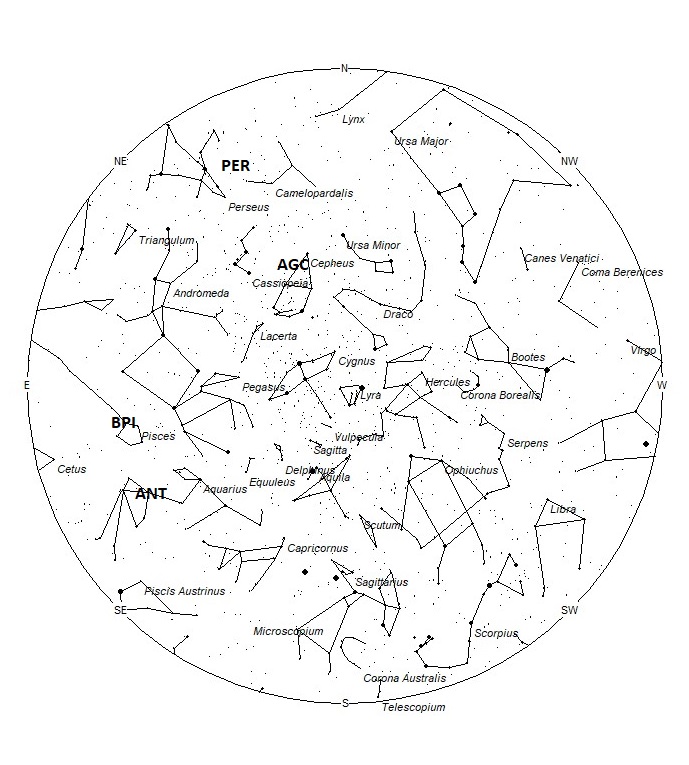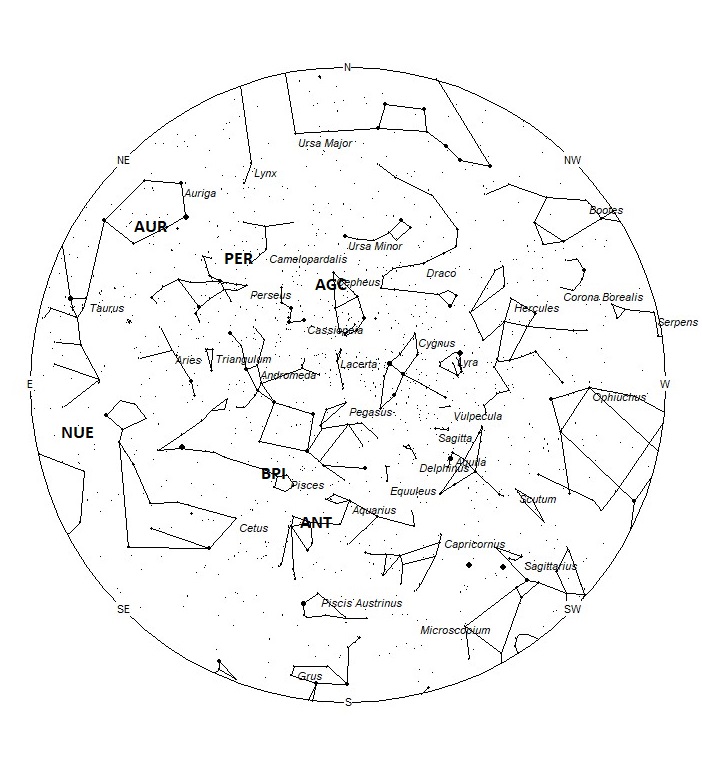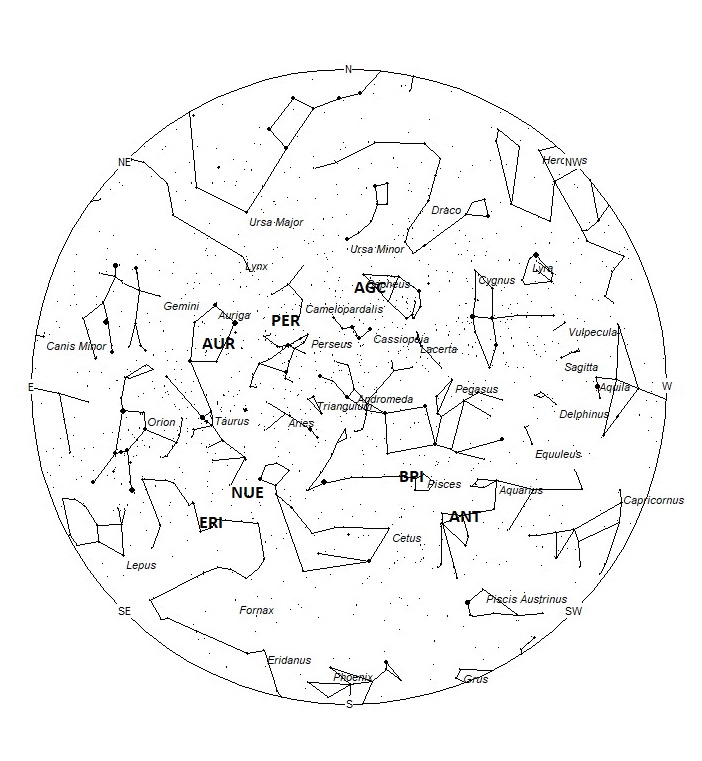
During this period, the moon reaches its first quarter phase on Wednesday August 26th. At this time, the moon is located 90 degrees east of the sun and sets between midnight and 0100 local daylight saving time (LDST). This weekend the waxing crescent moon will set during the early evening hours and will not interfere with the more active morning hours. The estimated total hourly meteor rates for evening observers this week is near 4 as seen from mid-northern latitudes and 3 as seen from tropical southern locations (25S). For morning observers, the estimated total hourly rates should be near 19 as seen from mid-northern latitudes (45N) and 11 as seen from tropical southern locations (25S). The actual rates will also depend on factors such as personal light and motion perception, local weather conditions, alertness, and experience in watching meteor activity. Evening rates are reduced due to moonlight. Note that the hourly rates listed below are estimates as viewed from dark sky sites away from urban light sources. Observers viewing from urban areas will see less activity as only the brighter meteors will be visible from such locations.
The radiant (the area of the sky where meteors appear to shoot from) positions and rates listed below are exact for Saturday night/Sunday morning August 22/23. These positions do not change greatly day to day so the listed coordinates may be used during this entire period. Most star atlases (available at science stores and planetariums) will provide maps with grid lines of the celestial coordinates so that you may find out exactly where these positions are located in the sky. A planisphere or computer planetarium program is also useful in showing the sky at any time of night on any date of the year. Activity from each radiant is best seen when it is positioned highest in the sky, either due north or south along the meridian, depending on your latitude. It must be remembered that meteor activity is rarely seen at the radiant position. Rather they shoot outwards from the radiant, so it is best to center your field of view so that the radiant lies at the edge and not the center. Viewing there will allow you to easily trace the path of each meteor back to the radiant (if it is a shower member) or in another direction if it is a sporadic. Meteor activity is not seen from radiants that are located far below the horizon. The positions below are listed in a west to east manner in order of right ascension (celestial longitude). The positions listed first are located further west therefore are accessible earlier in the night while those listed further down the list rise later in the night.
These sources of meteoric activity are expected to be active this week.
.
The center of the large Anthelion (ANT) radiant is currently located at 22:48 (342) -07. This position lies in central Aquarius, near the spot occupied by the 4th magnitude star known as Hydor (lambda Aquarii). Due to the large size of this radiant, anthelion activity may also appear from western Pisces as well as central Aquarius. This radiant is best placed near 0200 LDST, when it lies on the meridian and is located highest in the sky. Rates at this time should be near 2 per hour as no matter your location. With an entry velocity of 30 km/sec., the average anthelion meteor would be of slow velocity.
The August gamma Cepheids (AGC) are a recent discovery by Damir Šegon and the Croatian Meteor Network team based on studying SonotaCo and CMN observations (SonotaCo 2007-2011, CMN 2007-2010). This source is listed as “working” on the IAU website but investigations by Masahiro Koseki have shown that the radiant density ratio is among the highest of all known showers.* This helps prove that this source is real, and I believe it is within reach of visual observers in the northern hemisphere. Meteors from this source are expected from August 19 through September 7, with maximum activity occurring on August 28. The current position lies at 23:30 (353) +74, which lies in northern Cepheus, 2 degrees southeast of the 4th magnitude star known as pi Cephei. This radiant is best placed near 0300 LDST, when it lies on the meridian and is located highest in the sky. Rates at this time should be less than 1 per hour as no matter your location. With an entry velocity of 44 km/sec., the average meteor would be of medium-fast velocity.
The August beta Piscids (BPI) are synonymous with the northern delta Aquariids (NDA). Although the BPI’s have been removed from the IAU’s shower list, it best represents the classical activity of the NDA’s, first mentioned by Luigi G. Jacchia in his book The Moon, Meteorites and Comets. The peak, on August 13th, also occurs with the radiant within the borders of the constellation of Pisces. The radiant currently is located near 23:42 (336) +06. This area of the sky is located 1 degree north of the 4th magnitude star known as iota Piscium. This radiant is best placed near 0300 LDST, when it lies on the meridian and is located highest in the sky. Hourly rates at this time should be less than 1 no matter your location. With an entry velocity of 38 km/sec., the average meteor from this source would be of medium-slow velocity.
The nu Eridanids (NUE) become active this week. This source was co-discovered by Japanese observers using SonotoCo and Juergen Rendtel and Sirko Molau of the IMO. Activity from this long-period stream stretches from August 24 all the way to November 16. Maximum activity occurs on September 24th. The radiant currently lies at 03:06 (047) +00, which places it in northeastern Cetus, 4 degrees south of the 3rd magnitude star known as Menkar (alpha Ceti). This area of the sky is best seen during the last dark hour before dawn when the radiant lies highest in a dark sky. Current rates are expected to be less than 1 per hour during this period no matter your location. With an entry velocity of 67 km/sec., the average meteor from this source would be of swift velocity.
The eta Eridanids (ERI) are active from a radiant located near 03:38 (054) -09. This position lies in northern Eridanus, between the 4th magnitude stars known as delta and epsilon Eridani. This source is active until September 16th, with maximum activity having occurred on August 10th. Current rates are expected to be near 1 per hour no matter your location. These meteors are best seen during the last dark hour prior to dawn when the radiant lies highest above the horizon in a dark sky. With an entry velocity of 65 km/sec., the average meteor from this source would be of swift speed.
The last of the Perseids (PER) will be seen this week from a radiant located at 04:12 (063) +60. This position lies in southwestern Camelopardalis, 12 degrees northeast of the 2nd magnitude star known as Mirfak (alpha Persei). This area of the sky is best placed for viewing during the last dark hour before dawn when it lies highest in the sky. Rates just prior to dawn are expected to be near 2 per hour as seen from the northern hemisphere and less than 1 per hour as seen from south of the equator. With an entry velocity of 59 km/sec., the average meteor from this source would be of swift velocity.
The Aurigids (AUR) are active from a radiant located at 05:19 (080) +39. This position lies in central Auriga, near the spot occupied by the faint star known as mu Aurigae. This area of the sky is best seen during the last dark hour before dawn when the radiant lies highest in a dark sky. Current rates are expected to be less than 1 per hour no matter your location. Maximum activity is not expected until August 31st. With an entry velocity of 67 km/sec., the average meteor from this source would be of swift velocity.
Morning sporadic rates are expected to be near 14 per hour as seen from mid-northern latitudes and 8 as seen from tropical southern latitudes. Evening rates should be near 3 as seen from the northern hemisphere and 2 as seen from tropical southern latitudes. Evening rates are reduced due to interfering moonlight. The list below offers the information from above in tabular form. Rates and positions are exact for Saturday night/Sunday morning except where noted in the shower descriptions.
| SHOWER | DATE OF MAXIMUM ACTIVITY | CELESTIAL POSITION | ENTRY VELOCITY | CULMINATION | HOURLY RATE | CLASS |
| RA (RA in Deg.) DEC | Km/Sec | Local Daylight Saving Time | North-South | |||
| Anthelion (ANT) | – | 22:48 (342) -07 | 30 | 02:00 | 2 – 2 | II |
| August gamma Cepheids (AGC) | Aug 28 | 23:30 (353) +74 | 44 | 03:00 | <1 – <1 | IV |
| August beta Piscids (BPI) | Aug 13 | 23:42 (336) +06 | 41 | 03:00 | <1 – <1 | IV |
| nu Eridanids (NUE) | Sep 24 | 03:06 (047) +00 | 67 | 06:00 | <1 – <1 | IV |
| eta Eridanids (ERI) | Aug 10 | 03:38 (054) -09 | 65 | 06:00 | 1 – 1 | IV |
| Perseids (PER) | Aug 12 | 04:12 (063) +60 | 59 | 07:00 | 2 – <1 | I |
| Aurigids (AUR) | Aug 31 | 05:19 (080) +39 | 67 | 08:00 | <1 – <1 | II |
 American Meteor Society
American Meteor Society



I am interested in following Washington DC area viewable astronomical activity.
The information provided in the weekly meteor outlooks is good for the Washington DC area and the rest of the USA too.
There was a comet going from east to west in the early hours of 26 8 20 over orkney with a trail behind it that was in the sky for over an hour the time was approx 04 10